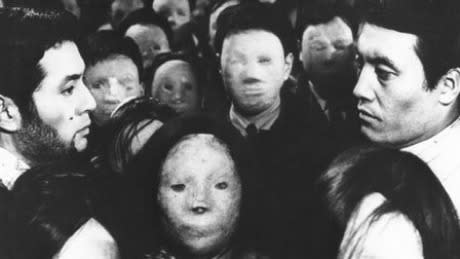While a plot, central characters and a general application of narrative structure—premise, building blocks, application of didactic and resulting, transformative outcome—are all present, Hiroshi Teshigahara's adaptation of the Kobo Abe novel, The Face of Another is largely theoretical, like a filmed essay.
Filmed in black and white and in full-frame aspect ratio, though the formats had already evolved in its time, the modernist aesthetic and application of future Science played at deliberate odds with the style used on Teshigahara's earlier films, Pitfall and Woman in the Dunes. Like those films, Face deals with the nature of identity as presentation. Bodily scrutiny and dissection of psychology as something masked is made very literal with the story of Mr. Okuyama (Tatsuya Nakadai), a man disfigured in an industrial accident and forced to wear bandages over his entire face.
Dr. Hira (Mikijirô Hira), a psychiatrist, offers to make a lifelike mask for his patient, but warns him of adverse side effects to his personality, noting that confidence, id impulse and an inflated sense of emotional protection stem from wearing the titular "face of another." These theoretical concepts are discussed verbatim for a large portion of the film, with the notion of Okuyama seducing his wife while masked being the ultimate form of taboo within the context of this 1960s social examination.
As Okuyama's confidence builds, his mirrored meetings with a mentally handicapped girl in his rental building—masked and unmasked—question the idea of identity deception when she is able to see through the superficial. If someone with mental limitations can see through it, what does it mean when those of normal intellect are deceived?
Interspersed throughout the story is a subplot involving a facially scarred young woman (Miki Irie)—presumably during WWII—suffering through the experience of being deemed a monster in a social context, terrified of another impending war. Unable to establish or perform an identity, she projects her repressed and distorted sexuality onto her brother.
These two storylines, presented in a deliberately analytical capacity, assess the nature of facial recognition and interpretation of the self as superficial element on a social capacity. It criticises our basis tendency to judge based on what we see, while also warning that these physical identifiers are what keep our morality and sense of social order in check.
Though The Face of Another pales in comparison to some of Teshigahara's earlier works, it holds up as a timeless and universal work of incisive magnitude. Many films have since tackled the idea of identity as a mask, but few with the acuity and balance demonstrated in this eerie, existential social horror.
The Face of Another screens at the TIFF Bell Lightbox as part of the Japanese Divas retrospective at 7:15 on March 16, 2013.
(Teshigahara Productions)Filmed in black and white and in full-frame aspect ratio, though the formats had already evolved in its time, the modernist aesthetic and application of future Science played at deliberate odds with the style used on Teshigahara's earlier films, Pitfall and Woman in the Dunes. Like those films, Face deals with the nature of identity as presentation. Bodily scrutiny and dissection of psychology as something masked is made very literal with the story of Mr. Okuyama (Tatsuya Nakadai), a man disfigured in an industrial accident and forced to wear bandages over his entire face.
Dr. Hira (Mikijirô Hira), a psychiatrist, offers to make a lifelike mask for his patient, but warns him of adverse side effects to his personality, noting that confidence, id impulse and an inflated sense of emotional protection stem from wearing the titular "face of another." These theoretical concepts are discussed verbatim for a large portion of the film, with the notion of Okuyama seducing his wife while masked being the ultimate form of taboo within the context of this 1960s social examination.
As Okuyama's confidence builds, his mirrored meetings with a mentally handicapped girl in his rental building—masked and unmasked—question the idea of identity deception when she is able to see through the superficial. If someone with mental limitations can see through it, what does it mean when those of normal intellect are deceived?
Interspersed throughout the story is a subplot involving a facially scarred young woman (Miki Irie)—presumably during WWII—suffering through the experience of being deemed a monster in a social context, terrified of another impending war. Unable to establish or perform an identity, she projects her repressed and distorted sexuality onto her brother.
These two storylines, presented in a deliberately analytical capacity, assess the nature of facial recognition and interpretation of the self as superficial element on a social capacity. It criticises our basis tendency to judge based on what we see, while also warning that these physical identifiers are what keep our morality and sense of social order in check.
Though The Face of Another pales in comparison to some of Teshigahara's earlier works, it holds up as a timeless and universal work of incisive magnitude. Many films have since tackled the idea of identity as a mask, but few with the acuity and balance demonstrated in this eerie, existential social horror.
The Face of Another screens at the TIFF Bell Lightbox as part of the Japanese Divas retrospective at 7:15 on March 16, 2013.
